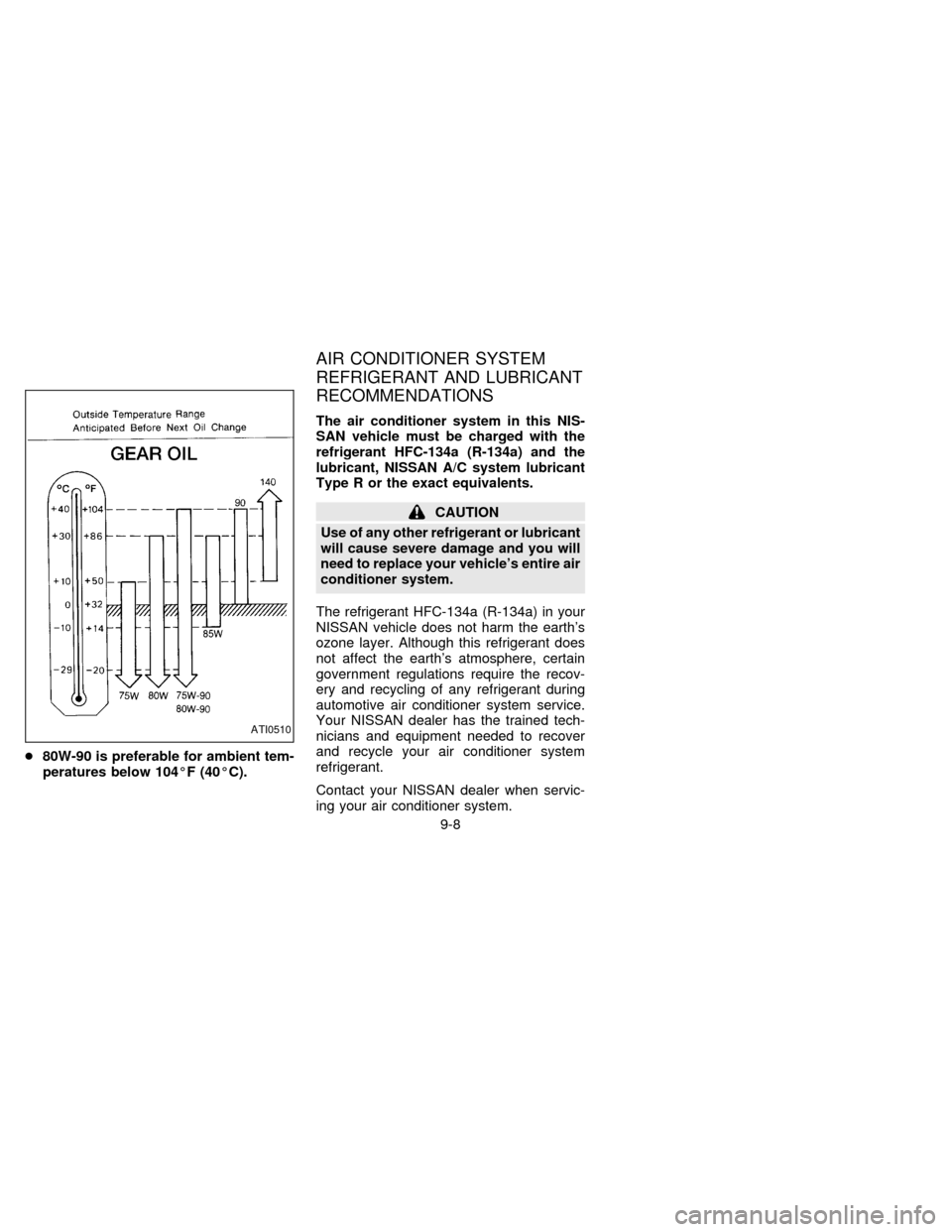1997 NISSAN FRONTIER service
[x] Cancel search: servicePage 176 of 204

Octane rating tips
In most parts of North America, you should
use unleaded gasoline with an octane rating
of at least 87 AKI (Anti-Knock Index). How-
ever, you may use unleaded gasoline with
an octane rating as low as 85 AKI in high
altitude areas (over 4,000 ft [1,219 m]) such
as: Colorado, Montana, New Mexico, Utah,
Wyoming, northeastern Nevada, southern
Idaho, western South Dakota, western Ne-
braska, and that part of Texas which is
directly south of New Mexico.
Using unleaded gasoline with an octane
rating lower than stated above can cause
persistent, heavy ``spark knock.'' (``Spark
knock'' is a metallic rapping noise.) If
severe, this can lead to engine damage. If
you detect a persistent heavy spark
knock even when using gasoline of the
stated octane rating, or if you hear steady
spark knock while holding a steady speed
on level roads, have your dealer correct
the condition. Failure to correct the con-
dition is misuse of the vehicle, for which
NISSAN is not responsible.
Incorrect ignition timing results in knocking,
after-run and/or overheating. This in turn
may cause excessive fuel consumption ordamage to the engine. If any of the above
symptoms are encountered, have your ve-
hicle checked at a NISSAN dealer or other
competent service facility.
However, now and then you may notice
light spark knock for a short time while
accelerating or driving up hills. This is
no cause for concern, because you get
the greatest fuel benefit when there is
light spark knock for a short time under
heavy engine load.
9-5
ZX
Page 177 of 204

ENGINE OIL AND OIL FILTER
RECOMMENDATION
Selecting the correct oil
It is essential to chose the correct quality
and viscosity oil to ensure satisfactory en-
gine life and performance. NISSAN recom-
mends the use of a low friction oil (energy
conserving oil) in order to improve fuel
economy and conserve energy. Oils which
do not have the specified quality label
should not be used as they could cause
engine damage.Only those engine oils with the American
Petroleum Institute (API) CERTIFICATION
MARK on the front of the container should
be used. This type of oil supersedes the
existing API SG or SH and Energy Conserv-
ing II categories.
If you cannot find engine oil with the CERTI-
FICATION MARK, an API SG or SH and
Energy Conserving II oil with API Service
Symbol may be used. An oil with a single
designation SG or SH, or in combination with
other categories (for example, SG/CC or
SG/CD) may also be used if one with the API
CERTIFICATION MARK cannot be found.
Mineral based or synthetic type oils may be
used in your NISSAN vehicle. These oils
must however, meet the API quality and
SAE viscosity ratings specified for your ve-
hicle. Do not mix mineral based and syn-
thetic type oils in the engine at the same
time.
Oil additives
NISSAN does not recommend the use of oil
additives. The use of an oil additive is not
necessary when the proper oil type is used
and maintenance intervals are followed.
Oil which may contain foreign matter or has
been previously used should not be used.
Oil viscosity
The engine oil viscosity or thickness
changes with temperature. Because of this,
it is important that the engine oil viscosity be
selected based on the temperatures at
which the vehicle will be operated before
the next oil change. The chart ``Recom-
mended SAE viscosity number'' shows the
recommended oil viscosities for the ex-
pected ambient temperatures. Choosing an
oil viscosity other than that recommended
could cause serious engine damage.
ATI0507
9-6
ZX
Page 179 of 204

c80W-90 is preferable for ambient tem-
peratures below 104ÉF (40ÉC).
AIR CONDITIONER SYSTEM
REFRIGERANT AND LUBRICANT
RECOMMENDATIONS
The air conditioner system in this NIS-
SAN vehicle must be charged with the
refrigerant HFC-134a (R-134a) and the
lubricant, NISSAN A/C system lubricant
Type R or the exact equivalents.
CAUTION
Use of any other refrigerant or lubricant
will cause severe damage and you will
need to replace your vehicle's entire air
conditioner system.
The refrigerant HFC-134a (R-134a) in your
NISSAN vehicle does not harm the earth's
ozone layer. Although this refrigerant does
not affect the earth's atmosphere, certain
government regulations require the recov-
ery and recycling of any refrigerant during
automotive air conditioner system service.
Your NISSAN dealer has the trained tech-
nicians and equipment needed to recover
and recycle your air conditioner system
refrigerant.
Contact your NISSAN dealer when servic-
ing your air conditioner system.
ATI0510
9-8
ZX
Page 193 of 204

prevent load shifts while driving.
cBe certain your outside mirrors conform
to all federal, state or local regulations. If
not, install any mirrors required for towing
before driving the vehicle.
Trailer towing tips
In order to gain skill and an understanding
of the vehicle's behavior, you should prac-
tice turning, stopping and backing up in an
area which is free from traffic. Steering,
stability and braking performance will be
somewhat different than under normal driv-
ing conditions.
cAlways secure items in the trailer to
prevent load shift while driving.
c
Avoid abrupt starts, acceleration or stops.
cAvoid sharp turns or lane changes.
cAlways drive your vehicle at a moderate
speed.
cAlways block the wheels on both vehicle
and trailer when parking. Parking on a
slope is not recommended; however, if
you must do so, and if your vehicle is
equipped with automatic transmission,
first block the wheels and apply the park-ing brake, and then move the transmis-
sion shift lever into the P position. If you
move the shift lever to the P position
before blocking the wheels and applying
the parking brake, transmission damage
could occur.
cWhen going down a hill, shift into a lower
gear and use the engine braking effect.
When ascending a long grade, downshift
the transmission to a lower gear and
reduce speed to reduce chances of en-
gine overloading and/or overheating.
However, for long steep grades, do not
stay in 1st or 2nd gear when driving
above 35 MPH (56 km/h).
cIf the engine coolant rises to an ex-
tremely high temperature when the air
conditioning system is on, turn off the air
conditioner. Coolant heat can be addi-
tionally vented by opening the windows,
switching the fan control to high and
setting the temperature control to the
HOT position.
cTrailer towing requires more fuel than
normal circumstances.
cAvoid towing a trailer for your vehicle's
first 500 miles (805 km).cHave your vehicle serviced more often
than at intervals specified in the recom-
mended Maintenance Schedule.
cWhen making a turn, your trailer wheels
will be closer to the inside of the turn than
your vehicle wheels. To compensate for
this, make a larger than normal turning
radius during the turn.
cCrosswinds and rough roads adversely
affect vehicle/trailer handling, possibly
causing vehicle sway. When being
passed by larger vehicles, be prepared
for possible changes in crosswinds that
could affect vehicle handling. If swaying
does occur, firmly grip the steering
wheel, steer straight ahead, and immedi-
ately (but gradually) reduce vehicle
speed. This combination helps to stabi-
lize the vehicle. Never increase speed.
cBe careful when passing other vehicles.
Passing while towing a trailer requires
considerably more distance than normal
passing. Remember the length of the
trailer must also pass the other vehicle
before you can safely change lanes.
cTo maintain engine braking efficiency
and electrical charging performance, do
9-22
ZX
Page 194 of 204

not use fifth gear (manual transmission)
or overdrive (automatic transmission).
cAvoid holding the brake pedal down too
long or too frequently. This could cause
the brakes to overheat, resulting in re-
duced braking efficiency.
When towing a trailer, change oil in the
transmission more frequently. See the
Maintenance Schedule.DOT Quality Grades: All passenger car tires
must conform to Federal Safety Require-
ments in addition to these grades.
Treadwear
Treadwear grade is a comparative rating
based on tire wear rate when tested under
controlled conditions on specified govern-
ment test courses. For example, a tire
graded 150 would wear one and a half
(1-1/2) times as well on the government
course as a tire graded 100. However,
relative tire performance depends on actual
driving conditions, and may vary signifi-
cantly from the norm due to variations in
driving habits, service practices and differ-
ences in road characteristics and climate.
Traction A, B and C
Traction grades are A (the highest), B and
C. They represent a tire's ability to stop on
wet pavement as measured under con-
trolled conditions, on specified government
test surfaces of asphalt and concrete. A tire
marked with a C may have poor traction
performance.
WARNING
The traction grade assigned to your
vehicle tires is based on straight line
braking traction tests and does not
include cornering (turning) traction.
Temperature A, B and C
Temperature grades are A (the highest), B,
and C. They represent a tire's resistance to
heat build-up, and its ability to dissipate
heat when tested under controlled condi-
tions on a specified indoor laboratory test
wheel. Sustained high temperature can
cause tire material to degenerate, reducing
tire life. Excessive temperatures can lead to
sudden tire failure. Grade C corresponds to
a performance level which all passenger car
tires must meet under the Federal Motor
Vehicle Safety Standard No. 109. Grades A
and B represent higher levels of perfor-
mance on laboratory test wheels than the
minimum required by law.
UNIFORM TIRE QUALITY
GRADING
9-23
ZX
Page 197 of 204

A genuine NISSAN Service Manual is the best
source of service and repair information for
your vehicle. Filled with wiring diagrams, illus-
trations and step-by-step diagnostic and ad-
justment procedures, this manual is the same
one used by the factory trained technicians
working at your NISSAN dealership. Also avail-
able are genuine NISSAN Owner's Manuals.
For current pricing and availability of a genuine
NISSAN Service Manual or genuine NISSAN
Owner's Manual, contact:
In the USA:
See your NISSAN dealer or contact:
Dyment Distribution Services
20770 Westwood Dr.
Strongsville OH 44136
In a hurry? Call 1-800-247-5321 and charge
your purchase to Visa/Master Card.
In Canada:
To purchase a copy of a genuine NISSAN
Service Manual or Owner's Manual please
contact your nearest NISSAN dealer. For the
phone number and location of a NISSAN
Dealer in your area call the NISSAN Satisfac-
tion Center at 1-800-387-0122 and a bilingual
NISSAN representative will assist you.
Also available are Genuine NISSAN Service
and Owner's Manuals for older NISSAN
models.
9-26
ZX
Page 198 of 204

10 Index
A
Air bag (See supplemental restraint
system) ...................................................... 2-15
Air bag warning light .................................. 2-17
Air cleaner housing filter ............................ 7-16
Air conditioner
Air conditioner operation ........................ 3-5
Air conditioner service ............................ 3-9
Air conditioner specification label ......... 9-14
Air conditioner system refrigerant and
lubrication recommendations.................. 9-8
Heater and air conditioner controls ........ 3-3
Air flow charts .............................................. 3-6
Anchor point locations ............................... 2-29
Antenna (manual) ...................................... 3-20
Anti-lock brake system, rear (R-ABS) ....... 4-25
Ashtray (See cigarette lighter and
ashtray) ...................................................... 1-13
Audio system
AM-FM radio with cassette player ........ 3-11
AM-FM radio with cassette player
(100W) .................................................. 3-16
Auto-lock free-running hubs ...................... 4-16
Automatic
Automatic power window switch .......... 1-16
Automatic transmission fluid (ATF) ........ 7-9
Driving with automatic transmission ....... 4-6B
Battery........................................................ 7-13
Before starting the engine ........................... 4-6
Belts (See drive belts) ............................... 7-14
Brake
Anti-lock brake system, rear
(R-ABS) ................................................ 4-25
Brake booster ....................................... 7-19
Brake fluid ..................................... 7-11, 9-3
Brake light (See stop light) ................... 7-23
Brake pedal .......................................... 7-18
Brake system ........................................ 4-25
Brake warning light ................................. 1-7
Brake wear indicators ................... 1-9, 7-19
Parking brake check ............................. 7-18
Parking brake operation ....................... 4-11
Break-in schedule ...................................... 4-14
Bulb check/instrument panel ....................... 1-6
Bulb replacement ....................................... 7-23
C
Capacities and recommended fuel/
lubricants...................................................... 9-2
Cargo (See vehicle loading
information) ................................................ 9-15
Cassette player (See audio system) ......... 3-11CB radio or car phone ............................... 3-21
Check engine indicator light (See malfunction
indicator light) .............................................. 1-9
Child restraint with top tether strap ........... 2-28
Child restraints for infants and small
children ...................................................... 2-24
Cigarette lighter (accessory) and
ashtray ....................................................... 1-13
Cleaning exterior and interior ...................... 6-2
Clock ............................................................ 1-5
Clock-radio ................................................. 3-11
Clutch
Clutch fluid ............................................ 7-11
Clutch pedal.......................................... 7-20
Cold weather driving .................................. 4-27
Controls
Audio controls ............................. 3-11, 3-16
Heater and air conditioner controls ........ 3-3
Coolant
Capacities and recommended fuel/
lubricants ................................................ 9-2
Changing engine coolant........................ 7-5
Checking engine coolant level ............... 7-4
Engine coolant temperature gauge ........ 1-4
Corrosion protection .................................... 6-4
Cruise control............................................. 4-12
Cup holder ................................................. 1-13
ZX
Page 201 of 204

Checking engine oil level ....................... 7-6
Engine oil ................................................ 7-6
Engine oil and oil filter
recommendation ..................................... 9-6
Engine oil viscosity ................................. 9-7
Opera window ............................................ 1-17
Outside mirror control ................................ 2-30
Outside mirrors .......................................... 2-30
Overdrive switch .......................................... 4-8
Overheat
If your vehicle overheats ........................ 5-9
Owner's manual order form ....................... 9-26
P
Pantograph type jack ................................... 5-5
Parking
Parking brake check ............................. 7-18
Parking brake operation ....................... 4-11
Parking/parking on hills ........................ 4-23
Periodic maintenance schedules ................. 8-5
Power
Power door lock...................................... 2-3
Power steering fluid .............................. 7-11
Power steering system ......................... 4-24
Power windows..................................... 1-15
Precautions
Maintenance precautions ....................... 7-2
On-pavement and off-road driving
precautions ............................................. 4-3
Precautions on seat belt usage............ 2-19Precautions when starting and
driving ..................................................... 4-2
Push starting ................................................ 5-9
R
Radio
AM-FM radio with cassette player ........ 3-11
AM-FM radio with cassette player
(100W) .................................................. 3-16
CB radio or car phone .......................... 3-21
Readiness for inspection maintenance
(I/M) test..................................................... 9-25
Rear anti-lock brake warning light ............... 1-9
Rear sliding window................................... 1-16
Registering your vehicle in another
country ....................................................... 9-12
Reporting safety defects (USA) ................. 9-24
S
Safety
Reporting safety defects (USA) ............ 9-24
Screw type jack ........................................... 5-6
Seat
Jump seat ............................................. 2-13
Seat belt
2-point type without retractor................ 2-23
3-point type with retractor..................... 2-21
Precautions on seat belt usage............ 2-19
Seat belt extenders .............................. 2-24Seat belt maintenance.......................... 2-24
Seat belts.............................................. 2-19
Seat belt warning light ................................. 1-7
Seats
Adjustment .............................................. 2-8
Bench seat............................................ 2-12
Separate seats ....................................... 2-8
Service manual order form ........................ 9-26
Shifting
Automatic transmission .......................... 4-7
Manual transmission............................... 4-9
Spark plug replacement............................. 7-15
Speedometer ............................................... 1-3
Spotlights ................................................... 1-14
SRS warning label ..................................... 2-17
Starting
Before starting the engine ...................... 4-6
Jump starting .......................................... 5-8
Precautions when starting and
driving ..................................................... 4-2
Push starting........................................... 5-9
Starting the engine ............................... 4-10
Steering
Power steering fluid .............................. 7-11
Power steering system ......................... 4-24
Tilting steering wheel............................ 2-29
Stop light .................................................... 7-23
Sun shade.................................................. 1-18
Sunroof ...................................................... 1-17
Supplemental restraint system
(Supplemental air bag system).................. 2-14
10-4
ZX